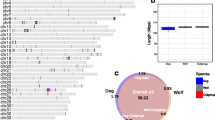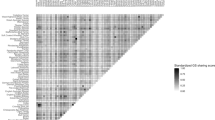Abstract
After the dog genome was sequenced, an increasing number of studies involving genetic research of dogs have been conducted to understand gene functions and mammalian evolution. To study the genetic diversity in dogs and other mammals, genetic markers linked to function and conserved in wide lineages are necessary. Thus far, few polymorphic markers have been used in dogs. In this study, we surveyed the entire dog genome and predicted a total of 109 tandem repeats (TRs) located on the protein coding region that may be polymorphic by our prediction model. We selected 10 TRs that may be related to neurophysiology and neural developments, and tested them in 167 individuals of 8 dog breeds: 5 European dog breeds (Beagle, Golden Retriever, Labrador Retriever, German Shepherd, and Toy Poodle) and 3 Japanese dog breeds (Japanese Spitz, Shiba, and Shikoku). Among the tested TRs, nine were polymorphic indicating that 90% of the TRs were successfully predicted to be polymorphic. PCR fragments of the TRs were amplified from dog brain cDNA, showing their expression in the dog brain. Our results provide abundant opportunities for the study of phenotypic variations in dogs, and our prediction method for variable number of tandem repeats (VNTRs) can be applied to any other animal genome sequences for the survey of functional and polymorphic markers.
Similar content being viewed by others
References
Bachman ES, Dhillon H, Zhang CY, Cinti S, Bianco AC, Kobilka BK andLowell BB (2002) βAR signaling required for diet-induced thermogenesis and obesity resistance. Science 297: 843–845.
Ball DW, Azzoli CG, Baylin SB, Chi D, Dou S, Donis-Keller H, Cumaraswamy A, Borges M andNelkin BD (1993) Identification of a human achaete-scute homolog highly expressed in neuroendocrine tumors. Proc. Natl. Acad. Sci. USA 90: 5648–5652.
Bardoni B, Castets M, Huot ME, Schenck A, Adinolfi S, Corbin F, Pastore A, Khandjian EW andMandel JL (2003) 82-FIP, a novel FMRP (fragile X mental retardation protein) interacting protein, shows a cell cycle-dependent intracellular localization. Hum. Mol. Genet. 12: 1689–1698.
Bardoni B, Giglio S, Schenck A, Rocchi M andMandel JL (2000) Assignment of NUFIP1 (nuclear FMRP interacting protein 1) gene to chromosome 13q14 and assignment of a pseudogene to chromosome 6q12. Cytogenet. Cell Genet. 89: 11–13.
Benton CS, de Silva R, Rutledge SL, Bohlega S, Ashizawa T andZoghbi HY (1998) Molecular and clinical studies in SCA-7 define a broad clinical spectrum and the infantile phenotype. Neurology 51: 1081–1086.
Britto JM, Lukehurst S, Weller R, Fraser C, Qiu Y, Hertzog P andBusfield SJ (2004) Generation and characterization of neuregulin-2-deficient mice. Mol. Cell. Biol. 24: 8221–8226.
Brooks M andSargan DR (2001) Genetic aspects of disease in dogs. InThe Genetics of the Dog, A. Ruvinsky and J.Sampson, eds., CABI Publishing, New York, pp. 191–266.
Burden S andYarden Y (1997) Neuregulins and their receptors: a versatile signaling module in organogenesis and oncogenesis. Neuron 18: 847–855.
Bylund M, Andersson E, Novitch BG andMuhr J (2003) Vertebrate neurogenesis is counteracted by Sox1-3 activity. Nat. Neurosci. 6: 1162–1168.
Chamberlain NL, Driver ED andMiesfeld RL (1994) The length and location of CAG trinucleotide repeats in the androgen receptor N-terminal domain affect transactivation function. Nucleic Acids Res. 22: 3181–3186.
Chan EY, Nasir J, Gutekunst CA, Coleman S, Maclean A, Maas A, Metzler M, Gertsenstein M, Ross CA, Nagy A andHayden MR (2002) Targeted disruption ofHuntingtin-associated protein-1 (Hap1) results in postnatal death due to depressed feeding behavior. Hum. Mol. Genet. 11: 945–959.
Chung MY, Ranum LP, Duvick LA, Servadio A, Zoghbi HY andOrr HT (1993) Evidence for a mechanism predisposing to intergenerational CAG repeat instability in spinocerebellar ataxia type I. Nat. Genet. 5: 254–258.
Clutton-Brock J (1995) Origins of the dog: domestication and early history. InThe Domestic Dog, its Evolution, Behavior and Interactions with People J. Serpell, ed., Cambridge University Press, Cambridge, pp. 7–20.
Collignon J, Sockanathan S, Hacker A, Cohen-Tannoudji M, Norris D, Rastan S, Stevanovic M, Goodfellow PN andLovell-Badge R (1996) A comparison of the properties ofSox-3 with Sry and two related genes,Sox-1 andSox-2. Development 122: 509–520.
Cummings CJ andZoghbi HY (2000) Trinucleotide repeats: mechanisms and pathophysiology. Annu. Rev. Genomics Hum. Genet. 1: 281–328.
Dürr A, Stevanin G, Cancel G, Duyckaerts C, Abbas N, Didierjean O, Chneiweiss H, Benomar A, Lyon-Caen O, Julien J, Serdaru M, Penet C, Agid Y andBrice A (1996) Spinocerebellar ataxia 3 and Machado-Joseph disease: clinical, molecular, and neuropathological features. Ann. Neurol. 39: 490–499.
Ellegren H (2000) Microsatellite mutations in the germline: implications for evolutionary inference. Trends Genet. 16: 551–558.
Enard W, Przeworski M, Fisher SE, Lai CS, Wiebe V, Kitano T, Monaco AP andPääbo S (2002) Molecular evolution ofFOXP2, a gene involved in speech and language. Nature 418: 869–872.
Engelender S, Sharp AH, Colomer V, Tokito MK, Lanahan A, Worley P, Holzbaur EL andRoss CA (1997) Huntingtin-associated protein 1 (HAP1) interacts with the p150Glued subunit of dynactin. Hum. Mol. Genet. 6: 2205–2212.
Fondon JW 3rd andGarner HR (2004) Molecular origins of rapid and continuous morphological evolution. Proc. Natl. Acad. Sci. USA 101: 18058–18063.
Fu YH, Kuhl DP, Pizzuti A, Pieretti M, Sutcliffe JS, Richards S, Verkerk AJ, Holden JJ, Fenwick RG Jr andWarren ST (1991) Variation of the CGG repeat at the fragile X site results in genetic instability: resolution of the Sherman paradox. Cell 67: 1047–1058.
Fu YH, Pizzuti A, Fenwick RG Jr,King J, Rajnarayan S, Dunne PW, Dubel J, Nasser GA, Ashizawa T, de Jong P, Wieringa B, Korneluk R, Perryman MB, Epstein HF andCaskey CT (1992) An unstable triplet repeat in a gene related to myotonic muscular dystrophy. Science 255: 1256–1258.
Guillemot F, Lo LC, Johnson JE, Auerbach A, Anderson DJ andJoyner AL (1993) Mammalian achaete-scute homolog 1 is required for the early development of olfactory and autonomic neurons. Cell 75: 463–476.
Hurst JA, Baraitser M, Auger E, Graham F andNorell S (1990) An extended family with a dominantly inherited speech disorder. Dev. Med. Child Neurol. 32: 352–355.
Imbert G, Saudou F, Yvert G, Devys D, Trottier Y, Garnier JM, Weber C, Mandel JL, Cancel G, Abbas N, Dürr A, Didierjean O, Stevanin G, Agid Y andBrice A (1996) Cloning of the gene for spinocerebellar ataxia 2 reveals a locus with high sensitivity to expanded CAG/glutamine repeats. Nat. Genet. 14: 285–291.
Ito H, Nara H, Inoue-Murayama M, Shimada MK, Koshimura A, Ueda Y, Kitagawa H, Takeuchi Y, Mori Y, Murayama Y, Morita M, Iwasaki T, Ota K, Tanabe Y andIto S (2004) Allele frequency distribution of the canine dopamine receptor D4 gene exon III and I in 23 breeds. J. Vet. Med. Sci. 66: 815–820.
Karlin S, Brocchieri L, Bergman A, Mrazek J andGentles AJ (2002) Amino acid runs in eukaryotic proteomes and disease associations. Proc. Natl. Acad. Sci. USA 99: 333–338.
Kirkness EF, Bafna V, Halpern AL, Levy S, Remington K, Rusch DB, Delcher AL, Pop M, Wang W, Fraser CM andVenter JC (2003) The dog genome: survey sequencing and comparative analysis. Science 301: 1898–1903.
Lai CS, Fisher SE, Hurst JA, Vargha-Khadem F andMonaco AP (2001) A forkhead-domain gene is mutated in a severe speech and language disorder. Nature 413: 519–523.
Lu QR, Park JK, Noll E, Chan JA, Alberta J, Yuk D, Alzamora MG, Louis DN, Stiles CD, Rowitch DH andBlack PM (2001) Oligodendrocyte lineage genes (OLIG) as molecular markers for human glial brain tumors. Proc. Natl. Acad. Sci. USA 98: 10851–10856.
Lu QR, Sun T, Zhu Z, Ma N, Garcia M, Stiles CD andRowitch DH (2002) Common developmental requirement forOlig function indicates a motor neuron/oligodendrocyte connection. Cell 109: 75–86.
Maejima M, Inoue-Murayama M, Koshimura A, Kato S, Nara H, Randi E, Kitagawa H, Iwasaki T, Murayama Y andIto S (2005) Allelic variation of two polyglutamine repeats in the canine androgen receptor gene. J. Anim. Genet. 32: 3–11.
Martin JB (1993) Molecular genetics of neurological diseases. Science 262: 674–676.
Moody JA, Clark LA andMurphy KE (2006) Canine history and breed clubs. InThe Dog and its Genome, E.A. Ostrander, U. Giger and K. Lindblad-Toh, eds., Cold Spring Harbor Laboratory Press, NY, pp. 1–18.
Moseley ML, Benzow KA, Schut LJ, Bird TD, Gomez CM, Barkhaus PE, Blindauer KA, Labuda M, Pandolfo M, Koob MD andRanum LP (1998) Incidence of dominant spinocerebellar and Friedreich triplet repeats among 361 ataxia families. Neurology 51: 1666–1671.
Näslund K, Saetre P, von Salomé J, Bergström TF, Jareborg N andJazin E (2005) Genome-wide prediction of human VNTRs. Genomics 85: 24–35.
Nolan MF, Malleret G, Dudman JT, Buhl DL, Santoro B, Gibbs E, Vronskaya S, Buzsáki G, Siegelbaum SA, Kandel ER andMorozov A (2004) A behavioral role for dendritic integration: HCN1 channels constrain spatial memory and plasticity at inputs to distal dendrites of CA1 pyramidal neurons. Cell 119: 719–732.
O’Brien SJ, Menotti-Raymond M, Murphy WJ, Nash WG, Wienberg J, Stanyon R, Copeland NG, Jenkins NA, Womack JE andMarshall Graves JA (1999) The promise of comparative genomics in mammals. Science 286: 458–462, 479–481.
Ostrander EA andComstock KE (2004) The domestic dog genome. Curr. Biol. 14: R98-R99.
Parker HG, Kim LV, Sutter NB, Carlson S, Lorentzen TD, Malek TB, Johnson GS, DeFrance HB, Ostrander EA andKruglyak L (2004) Genetic structure of the purebred domestic dog. Science 304: 1160–1164.
Ponomareva ON, Fischer TM, Lai C andRimer M (2006) Schwann cell-derived neuregulin-2a can function as a cell-attached activator of muscle acetylcholine receptor expression. Glia 54: 630–637.
Ponomareva ON, Ma H, Dakour R, Raabe TD, Lai C andRimer M (2005) Stimulation of acetylcholine receptor transcription by neuregulin-2 requires an N-box response element and is regulated by alternative splicing. Neuroscience 134: 495–503.
Ranade K, Jorgenson E, Sheu WH, Pei D, Hsiung CA, Chiang FT, Chen YD, Pratt R, Olshen RA, Curb D, Cox DR, Botstein D andRisch N (2002) A polymorphism in the betal adrenergic receptor is associated with resting heart rate. Am. J. Hum. Genet. 70: 935–942.
Rubinsztein DC andHayden MR (1998)Analysis of Triplet Repeat Disorders. BIOS Scientific Publishers, Oxford, 352 pp.
Santoro B, Liu DT, Yao H, Bartsch D, Kandel ER, Siegelbaum SA andTibbs GR (1998) Identification of a gene encoding a hyperpolarization-activated pacemaker channel of brain. Cell 93: 717–729.
Sheng G, Chang GQ, Lin JY, Yu ZX, Fang ZH, Rong J, Lipton SA, Li SH, Tong G, Leibowitz SF andLi XJ (2006) Hypothalamic huntingtin-associated protein 1 as a mediator of feeding behavior. Nat. Med. 12: 526–533.
Shu W, Cho JY, Jiang Y, Zhang M, Weisz D, Elder GA, Schmeidler J, De Gasperi R, Sosa MA, Rabidou D, Santucci AC, Perl D, Morrisey E andBuxbaum JD (2005) Altered ultrasonic vocalization in mice with a disruption in theFoxp2 gene. Proc. Natl. Acad. Sci. USA 102: 9643–9648.
Wu L, Aster JC, Blacklow SC, Lake R, Artavanis-Tsakonas S andGriffin JD (2000) MAML1, a human homologue ofDrosophila mastermind, is a transcriptional co-activator for NOTCH receptors. Nat. Genet. 26: 484–489.
Wu L, Sun T, Kobayashi K, Gao P andGriffin JD (2002) Identification of a family of mastermind-like transcriptional coactivators for mammalian notch receptors. Mol. Cell. Biol. 22: 7688–7700.
Zhou Q andAnderson DJ (2002) The bHLH transcription factors OLIG2 and OLIG1 couple neuronal and glial subtype specification. Cell 109: 61–73.
Zhou Q, Wang S andAnderson DJ (2000) Identification of a novel family of oligodendrocyte lineage-specific basic helix-loop-helix transcription factors. Neuron 25: 331–343.
Author information
Authors and Affiliations
Corresponding author
Rights and permissions
About this article
Cite this article
Hong, KW., Nakae, Y., Kim, TH. et al. Prediction of tandem repeat polymorphisms in the coding region of dog genome. Genes & Genomics 31, 305–314 (2009). https://doi.org/10.1007/BF03191203
Received:
Accepted:
Issue Date:
DOI: https://doi.org/10.1007/BF03191203




